Towards Human-Centric, Traceable Negotiation Mechanisms for Sharing Autonomy in Multi-Agent Systems
Abstract
1. Introduction
2. Methodology
2.1. Analysis of Existing Findings
2.2. Proof of Concept
3. Fundamentals and Related Work
3.1. Fundamental Terms—Distribution/Allocation/Optimization
3.2. Task Allocation in Multi-Agent Systems
- Negotiations:
- Singhal and Dahiya [5] describe a system in which agents communicate with each other and, thus, assign tasks via negotiations. Initiator agents who cannot fulfill tasks alone form coalitions with others. The best coalition that maximizes system benefits is selected. In this approach, negotiations are used as an instrument to achieve a goal [5].
- Auctions:
- This type uses economic principles and allows agents to bid for tasks in auctions through a negotiation protocol [7]. At this point, it should be noted that the approach proposed by Skaltsis et al. [7] also implies negotiation in auction-based approaches. This approach is sometimes also referred to as a market-based approach [7,12]. The agents’ bids are based on their perception of the environment [7]. Agents bid based on a calculated benefit or costs and strive to achieve the highest benefit or the lowest cost for the given task(s) [7]. Auction-based approaches exhibit high solution efficiency, even if they do not always find the optimal solution [7].
- Game theory:
- In game theory approaches, agents are viewed as players who select specific actions [7]. The distribution of tasks is their strategy [7]. The reward for their actions at the end of the game is called the “payoff” [7]. Once they have chosen the best strategy, players do not change it [7]. There are two types of games: cooperative games, in which agents cooperate, and non-cooperative games, in which agents act selfishly [7].
- Optimization:
- Optimization is a mathematical field that finds solutions to problems by minimizing costs or maximizing profits [7]. For example, there is the deterministic “Hungarian” algorithm proposed by Kuhn [14], which makes use of graph theory. Metaheuristics include various methods, such as swarm intelligence, genetic algorithms, and simulated annealing [7].
- Machine Learning:
- In the paper by Skaltsis et al. [7], the possibilities of machine learning are discussed. The authors cite reinforcement learning as a typical example, enabling agents to use their experience to act accordingly.
- Hybrid approaches:
3.3. Selected Approaches
- Zhu et al.
- [9] consider game theory an effective tool, although this theory assumes that agents cannot communicate with each other. This can negatively impact the underlying use case (overall damage in the system). They also take a distributed system approach in which each agent has to make its own decision, making the system more flexible and robust. They also believe that the efficiency of the system can be maximized if the agents cooperate. They therefore opt for an automated negotiation system from the multi-agent area [9]. The description by Singhal and Dahiya [5] regarding the negotiation-based approach underlines this decision. It should be noted that in this context, the one task for which a coalition is to be formed represents the overall result of a system [5].
- Fiedler
- [8] opted for a negotiation-based approach, which is more akin to a “reverse” auction. They derived their decision from the fact that the negotiation-based approach can achieve a Pareto-efficient state in which no one is better off. This seems, to the author, to be a suitable solution concerning the use case for optimal financing.
- Rinaldi et al.
- [13] chose an auction-based approach based on the research result reported by Otte et al. [24], which indicates that multi-round auctions are very well-suited for constellations with communication losses. This is supported by the work of Skaltsis et al. [7], which demonstrates that auction-based approaches offer high solution efficiency.
4. Analysis of Negotiation Mechanisms
4.1. Assessment of Traceability
4.1.1. Evaluation Criteria
- Transparency at the model level (TM):
- This criterion assesses the transparency of the negotiation process within a workflow engine. It includes awareness of the rules and regulations before execution, the presentation of results, and the possibility of visual representation for third parties, e.g., a monitoring unit.
- Transparency at the instance level (TI):
- This criterion represents the extent to which it is possible to analyze decisions in the system by backtracking to their origins. In this way, tracing the path of a decision from the initial negotiation to the final allocation of tasks can be enabled.
- Comprehensibility (V):
- This criterion enables the determination of the protocol’s understandability, facilitating its implementation in a workflow engine. This property encompasses both the clarity of the process and the information necessary to negotiate.
- Documentation and logging (DP):
- This criterion refers to the intelligibility of documentation and details of the system’s activities and decisions. All relevant steps and changes occurring in the system must be traceable and accessible to third parties, e.g., accessible to an auditor. It should be noted that the capabilities of the execution unit can influence compliance with this criterion.
4.1.2. Analysis Items per Criterion
- Transparency at model the level (TM)
- TM1: Are the rules and procedures of the negotiation process known before the start of the negotiation?
- TM2: Can the negotiation steps be visualized and presented to third parties, such as a monitoring unit?
- TM3: Does the protocol provide a mechanism for all parties to the negotiations to be informed of the outcome?
- Transparency at the instance level (TI)
- TI1: Is it possible to trace decisions back to their origin?
- TI2: Are negotiation results assigned to the respective decision-making and discussion phase?
- TI3: Is there a procedure for recognizing and correcting information gaps that could impair the traceability of decisions?
- Comprehensibility (V)
- V1: Is the protocol clear and understandable for implementation in a workflow engine?
- V2: Is the information required to trigger and run negotiations easily accessible and clearly presented?
- V3: Are potential misunderstandings or stalemates addressed and clarified in the negotiation process?
- Documentation and logging (DP)
- DP1: Can the activities and decisions be documented in detail and comprehensively?
- DP2: Can all relevant steps be defined for third parties, for example, an external auditor?
- DP3: Is up-to-date and complete documentation always guaranteed in the event of controlled demolition?
4.1.3. Weighting per Criterion
- Transparency at the model level (35%):
- This criterion is crucial, as it forms the basis for visual monitoring, as well as trust and acceptance of the system.
- Transparency at the instance level (20%):
- The ability to trace decisions back to their origins is essential for troubleshooting and quality control. This criterion is necessary for analyzing and improving processes.
- Comprehensibility (20%):
- A clear and understandable protocol is essential for user-friendliness and effective integration into the system. However, it should be noted that comprehensibility may depend on the users’ qualifications.
- Documentation and logging (25%):
- Comprehensive documentation is necessary to ensure traceability and compliance. This criterion is essential in ensuring the integrity of the system and supporting audits.
4.2. Investigation of the Process Proposed by Rinaldi et al. [13]
- Initialization
- Create a list of all packages to be delivered and a list of all available agents.
- Define the parameters of the optimization function.
- Auction rounds
- Conduct an auction round for each outstanding task in which all drones place their bids for the package to be delivered.
- Bidding
- Each drone submits a bid for the current task based on the optimization function.
- Select the best bid
- The best bid among all submitted bids is selected.
- Assignment of the task
- The task is assigned to the drone with the best bid. This assignment is saved, and the task is removed from the list of open tasks.
- Repetition
- Repeat the auction process until all tasks have been distributed.
- Transparency at the model level (TM)
- TM1: Yes, the steps are defined in advance.
- TM2: Yes, the steps are known, so in principle, it is also possible to visualize them.
- TM3: No, there is no explicit mention of such a mechanism.
- Transparency at the instance level (TI)
- TI1: Yes, if the auction rounds and bids are documented, traceability is possible.
- TI2: Yes, a clear allocation is possible with documented auction rounds.
- TI3: No, there is no information on such a procedure.
- Comprehensibility (V)
- V1: Yes, the process seems straightforward enough for implementation. It should be noted that borderline cases are not covered.
- V2: No, the paper leaves room for interpretation. Details on decisions can be found in the pseudo-code. Consequently, understanding depends on the reader’s ability to apply that code.
- V3: No, there are no explicit specifications for addressing misunderstandings or stalemates.
- Documentation and logging (DP)
- DP1: Yes, since the steps are known, detailed and comprehensive documentation is possible.
- DP2: Yes, if documentation is possible, these steps can also be recorded for use by third parties.
- DP3: No, there is no explicit indication that controlled termination can occur.
4.3. Investigation of the Fiedler [8] Process
- Preparation phase:
- In preparation, a debt capital rate is determined that would be due from an external bank. This is also the starting bid for the negotiation.
- Negotiation and winner determination phase:
- A reverse auction characterizes the negotiation and winner determination phase:
- The mediator opens the auction with the previously determined interest rate.
- Interested internal investors submit a lower bid in each case.
- Uninterested investors drop out.
- A winner is not determined immediately. The lowest and therefore provisionally best bid is sought, which is also announced as the starting bid for the next round.
- Steps 2 and 3 are repeated either until no lower bids are submitted or all internal investors have exited.
- If no better bid can be found, the best provisional bid wins the auction and is therefore awarded the financing.
- If a provisionally best bid is found, the contract is awarded internally. Otherwise, the external bank wins. In either case, the winner is informed of the award.
- Preparation phase:
- It is assumed that no other service provider can currently offer delivery at the same speed. Consequently, the media provider determines a cost estimate in the form of delivery points during preparation. Delivery points represent the unit for evaluating the delivery. The lower the value, the more attractive it is for the mediator to award the contract. This value is also the starting bid for the negotiation.
- Negotiation and winner determination phase:
- A reverse auction characterizes the negotiation and winner determination phase:
- The mediator opens the auction with the previously determined delivery points.
- All agents submit one bid each—either a lower value or the information that they are dropping out.
- A winner is not determined immediately. The lowest and therefore provisionally best bid is sought, which is also announced as the starting bid for the next round.
- Steps 2 and 3 are repeated until either no new bids are submitted or all agents have dropped out.
- If no new, better bid is found, the best bid for the time being wins the auction and is therefore awarded the contract for delivery.
- If no best bid is found that comes from an agent, the auction is canceled and restarted. This step is currently necessary, as it is assumed in this scenario that an external award is not possible. The re-evaluation follows the same procedure as the preparation phase.
- The identified best bid must be accepted for it to be valid.
- Transparency at the model level (TM)
- TM1: Yes, the auction rules and process are clearly defined and documented.
- TM2: Yes, since the steps are known, it is possible to visualize them.
- TM3: No, there is no explicit mention of a stakeholder information mechanism about the result.
- Transparency at the instance level (TI)
- TI1: Yes, decisions can be traced based on the documented bids and the auction history.
- TI2: Yes, every decision can be assigned based on the auction history.
- TI3: No, there is no information on such a procedure.
- Comprehensibility (V)
- V1: Yes, the auction mechanism and the steps are clearly defined.
- V2: Yes, the information required to conduct the auction is accessible and understandable.
- V3: Yes, the procedure includes mechanisms for handling situations when no best offer can be identified, and the auction is canceled.
- Documentation and logging (DP)
- DP1: Yes, the auction process and the decisions can be documented.
- DP2: Yes, the documented data is suitable for an external review.
- DP3: Yes, in addition to the individual steps, it is also defined when a controlled termination can occur. As a result, up-to-date and complete documentation can always be guaranteed.
4.4. Investigation of the Process Proposed by Zhu et al. [9]
- Each agent (j) in the agent group suggests two values: and .
- represents the benefit when an additional agent is added to task j.
- represents the additional damage when an agent is removed from task j.
- A central agent collects these suggestions in two sequences: for additional agents and for remote agents.
- If the minimum of is greater than the maximum of , the algorithm terminates, as no further effective redistribution is possible.
- The algorithm identifies the agent (i) with the lowest value in and the agent (j) with the highest value in .
- If is smaller than , agent i transfers one of its agents to agent j, which increases the overall efficiency. Subsequently, both agents are removed from sequences and . If this condition is not met, the algorithm returns to step 1.
- The process is repeated until effective redistribution is no longer possible.
- Evaluation by each drone:
- Each drone (j) evaluates package i based on two criteria:
- –
- : How well does package i match drone j?
- –
- : What would be the disadvantage if drone j did not deliver package i?
- Central coordinator collects evaluations:
- The central coordinator collects the and valuations.
- Decision making:
- The central coordinator compares the assessments:
- –
- For each package (i), drone j is identified as that which offers the highest benefit () and the one that has the lowest disadvantage ().
- If the benefit () of assigning a drone (j) to a package (i) is greater than the disadvantage (), this drone is assigned to the package.
- Transparency at the model level (TM)
- TM1: No, the evaluation criteria are not entirely clear. The terms agent and task are sometimes used synonymously in the original form, making it difficult to interpret the application for the use case. It is also unclear whether success proven in the original paper is still valid under the given transformation.
- TM2: Yes, the evaluation and decision-making processes could be visualized.
- TM3: No, there is no explicit mention of a mechanism for informing the participants.
- Transparency at the instance level (TI)
- TI1: Yes, decisions can be traced back to individual assessments.
- TI2: Yes, each assignment can be traced back to specific assessments.
- TI3: No, there is no information on such a procedure.
- Comprehensibility (V)
- V1: No, the protocol is not entirely clear. The terms agent and task are sometimes used synonymously in the original form, making it difficult to interpret the transformation to the use case. It is also unclear whether the success proven in the original paper valid under the given transformation.
- V2: No, the terms agent and task are sometimes used synonymously in the original form, making it difficult to interpret the transformation to the use case. It is also unclear whether the success proven in the original paper is still valid under the given transformation.
- V3: No, there is no information on measures to avoid misunderstandings or stalemate situations.
- Documentation and logging (DP)
- DP1: Yes, the assessments and decision-making process can be documented.
- DP2: Yes, the documented data could be used for an external review.
- DP3: No, there is no indication of what happens, e.g., if an agent leaves the negotiation.
4.5. Consolidated Analysis
- Several agents take part in the hearing.
- A central office is responsible for conducting the negotiations.
- The agents must provide information so that a task can be distributed.
- An iterative process is followed in all three approaches.
- The overarching objective in each case is to maximize overall success.
5. Prototypical Implementation
5.1. Compunity ToolSuite
5.2. Procedure and Derivation of the Process Model
5.2.1. Procedure for Prototype Implementation
5.2.2. Textual Derivation—Consideration of Modeling Options
Analysis of the Negotiation Process
- Effort estimation:
- Based on the message about the package to be delivered, a detailed analysis and evaluation are necessary. The logistics domain includes various metrics to this end; however, these are not part of this work. Instead, a value is calculated for the simulation based on a random number and the package properties to transform the delivery requirements into quantifiable delivery points. At the same time, this value represents the starting bid for the auction and is sent to the next skill. Two input points (the Receive steps) are necessary—one for package distribution and one in case an auction needs to be restarted.
- Auction management:
- After the starting bid has been determined, the auction must be managed. The auction object including the starting bid must be sent to all agents. There is also the task of receiving bids or exit information and processing them accordingly. Corresponding status states are necessary to track the auction. In the reverse auction, bids are evaluated to determine the lowest acceptable bid at the time. This bid also serves as the new starting point for the next round. As the Compunity ToolSuite [27] does not provide for the dynamic, selective sending of messages, the process must be adapted so that all agents are always notified, even if they have already dropped out. The auction only ends when no lower bid is received. The winning agent must then be informed of the winning bid. Again, all agents are notified. If all agents drop out immediately in the first round, effort estimation is immediately carried out again. This step is necessary due to the process assumption that no alternative is available.
- Auction participation:
- Based on the received starting bid, either a lower bid or an exit is determined. Dropping out means that no lower bid can be submitted. If a bid has already been submitted and it was the best, the agent can still win the bid despite the withdrawal. In any case, the mediator is informed by a message. The exact calculation of the value is, again, the responsibility of the corresponding domain. For simulation purposes, a value is calculated using a random number and the packet properties. If an agent has already decided to exit in a previous round, it receives another bid request for the corresponding object. This is necessary due to the tool’s restrictions, which prevent messages from being sent or received dynamically and selectively. The process at the agent level is only terminated when a winner has been determined. This is necessary so that the bid instance remains active at the program level and any interim results can be accessed.
Quality of Traceability
5.3. Implementation Results
5.3.1. Modeling Result
- Special case:
- If two or more agents submit the same bid, the first in the list is the best. During the winner determination process, the provisional winner is identified, and a decision is made regarding the possibility of a lower bid. This decision is recorded in the form of an auction status. If yes, then this provisional best bid is sent out as the new starting bid (send bid). If not, it must be checked whether the auction needs to be restarted or whether there is a real winner. If a new auction has to be started, the original starting bid is sent back to effort estimation (Send new init Bid). In any case, a message is sent to all agents (Send Winner). If a real winner has been determined, the auction result is sent back (Send Auction Result), and the process ends. Furthermore, the monitoring messages (Send Monitoring MSG n) are also visible after each send, receive, and service step.
5.3.2. Model-to-Code Mapping
5.3.3. Code Documentation
5.3.4. Test Results
| Listing 1. Example JSON string. |
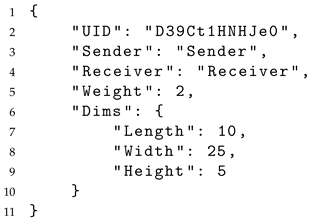 |
5.3.5. Test Without Restart
5.3.6. Test with Restart
6. Conclusions
- A significant limitation of this work concerns the lack of in-the-field conditions. Future research projects could focus on applying and testing the selected approach under real-world conditions to validate its practical applicability and robustness in dynamic, real-world scenarios.
- This work focused on the multi-agent domain. Future studies need to extend the analysis to other areas.
- Prototype implementation was tested in a controlled environment. Further research could investigate the scalability of the approach and evaluate its performance in larger, more complex environments and with a larger number of agents.
- This work focused on parcel delivery with autonomous agents. Further research could explore the application of the approach in other industries and assess its versatility and impact in different sectors.
Author Contributions
Funding
Data Availability Statement
Conflicts of Interest
References
- Obikhod, S.; Legeza, D.; Nestor, V.; Harvat, O.; Akhtoian, A. Digitization of Business Processes and the Impact on the Interaction of Business Entities. Econ. Aff. 2023, 68, 115–121. [Google Scholar] [CrossRef]
- Amazon. Amazon to Expand Prime Air Drone Delivery in Italy, UK, and U.S. 2023. Available online: https://www.aboutamazon.com/news/operations/amazon-prime-air-drone-delivery-updates (accessed on 4 October 2024).
- Heinrich, L.J.; Riedl, R.; Stelzer, D. Informationsmanagement: Grundlagen, Aufgaben, Methoden, 11th ed.; De Gruyter: Berlin, Germany, 2014. [Google Scholar]
- Amazon. How Amazon Is Building Its Drone Delivery System. 2022. Available online: https://www.aboutamazon.com/news/transportation/how-amazon-is-building-its-drone-delivery-system (accessed on 4 October 2024).
- Singhal, V.; Dahiya, D. Distributed task allocation in dynamic multi-agent system. In Proceedings of the International Conference on Computing, Communication & Automation, Greater Noida, India, 15–16 May 2015; IEEE: Piscataway, NJ, USA, 2015; pp. 643–648. [Google Scholar] [CrossRef]
- Charbonneau, D.; Dornhaus, A. When doing nothing is something. How task allocation strategies compromise between flexibility, efficiency, and inactive agents. J. Bioecon. 2015, 17, 217–242. [Google Scholar] [CrossRef]
- Skaltsis, G.M.; Shin, H.S.; Tsourdos, A. A survey of task allocation techniques in MAS. In Proceedings of the 2021 International Conference on Unmanned Aircraft Systems (ICUAS), Athens, Greece, 15–18 June 2021; IEEE: Piscataway, NJ, USA, 2021; pp. 488–497. [Google Scholar] [CrossRef]
- Fiedler, A. An agent-based negotiation protocol for supply chain finance. Comput. Ind. Eng. 2022, 168, 108136. [Google Scholar] [CrossRef]
- Zhu, J.; Shi, J.; Yang, Z.; Li, B. A real-time decentralized algorithm for task scheduling in multi-agent system with continuous damage. Appl. Soft Comput. 2019, 83, 105628. [Google Scholar] [CrossRef]
- Chen, Y.; Zhu, X.; Fang, K.; Wu, Y.; Deng, Y.; He, X.; Zou, Z.; Guo, T. An Optimization Model for Process Traceability in Case-Based Reasoning Based on Ontology and the Genetic Algorithm. IEEE Sens. J. 2021, 21, 25123–25132. [Google Scholar] [CrossRef]
- Heininger, R.; Jost, T.E.; Stary, C. Enriching socio-technical sustainability intelligence through sharing autonomy. Sustainability 2023, 15, 2590. [Google Scholar] [CrossRef]
- Quinton, F.; Grand, C.; Lesire, C. Market Approaches to the Multi-Robot Task Allocation Problem: A Survey. J. Intell. Robot. Syst. 2023, 107, 29. [Google Scholar] [CrossRef]
- Rinaldi, M.; Primatesta, S.; Guglieri, G.; Rizzo, A. Auction-based Task Allocation for Safe and Energy Efficient UAS Parcel Transportation. Transp. Res. Procedia 2022, 65, 60–69. [Google Scholar] [CrossRef]
- Kuhn, H.W. The Hungarian method for the assignment problem. Nav. Res. Logist. Q. 1955, 2, 83–97. [Google Scholar] [CrossRef]
- Mahanta, U. Beyond Automation: Guidelines for a Human-Centered Multi-Agent System for Coordinated Decision Making Under Industrial Settings. Master’s Thesis, Uppsala University, Uppsala, Sweden, 2025. [Google Scholar]
- Singh, M. Multi-agent systems: The future of distributed AI platforms for complex task management. World J. Adv. Res. Rev. 2025, 26–03, 48–55. [Google Scholar] [CrossRef]
- Yan, B.; Zhou, Z.; Zhang, L.; Zhang, L.; Zhou, Z.; Miao, D.; Li, Z.; Li, C.; Zhang, X. Beyond self-talk: A communication-centric survey of llm-based multi-agent systems. arXiv 2025, arXiv:2502.14321. [Google Scholar]
- Liu, Y.; Shi, L.; Song, R.; Xu, H. A Dual-Mind Framework for Strategic and Expressive Negotiation Agent. In Proceedings of the 63rd Annual Meeting of the Association for Computational Linguistics (Volume 1: Long Papers); Association for Computational: Vienna, Austria, 2025; pp. 23840–23860. [Google Scholar]
- Wu, J.; Sun, Y. An automated negotiation model based on agents’ attribute preference with emotional deception. Expert Syst. Appl. 2025, 278, 127448. [Google Scholar] [CrossRef]
- Jacob, A.P. Building Strategic AI Agents for Human-Centric Multi-Agent Systems. Ph.D. Thesis, Massachusetts Institute of Technology, Cambridge, MA, USA, 2024. [Google Scholar]
- Lang, F.; Fink, A. Kombinatorische Auktionen als Instrument zur Verhandlung von Verträgen mit interdependenten Eigenschaften. In Wirtschaftsinformatik Proceedings 2011; Association for Information Systems: Atlanta, GA, USA, 2011. [Google Scholar]
- oesterreich.gv.at-Redaktion. Verhandlung. 2024. Available online: https://www.oesterreich.gv.at/lexicon/V/Seite.991336.html (accessed on 4 October 2024).
- Wikipedia. Verhandlung—Wikipedia, Die Freie Enzyklopädie. 2023. Available online: https://de.wikipedia.org/w/index.php?title=Verhandlung&oldid=239236638 (accessed on 4 October 2024).
- Otte, M.; Kuhlman, M.J.; Sofge, D. Auctions for multi-robot task allocation in communication limited environments. Auton. Robot. 2020, 44, 547–584. [Google Scholar] [CrossRef]
- Zangemeister, C. Nutzwertanalyse in der Systemtechnik: Eine Methodik zur multidimensionalen Bewertung und Auswahl von Projektalternativen; BoD—Books on Demand: Norderstedt, Germany, 2014. [Google Scholar]
- Balzert, H.; Schröder, M.; Schäfer, C. Wissenschaftliches Arbeiten—Ethik, Inhalt & Form Wiss. Arbeiten, Handwerkszeug, Quellen, Projektmanagement, Präsentation, 3rd ed.; Prof. Balzert-Stiftung: Dortmund, Germany, 2022. [Google Scholar] [CrossRef]
- Compunity GmbH. Über Compunity—Compunity. 2024. Available online: https://compunity.eu/ (accessed on 4 October 2024).
- Microsoft Corporation. C#-Leitfaden—Verwaltete.NET-Sprache|Microsoft Learn. 2024. Available online: https://learn.microsoft.com/de-de/dotnet/csharp/ (accessed on 4 October 2024).
- Microsoft Corporation. Visual Studio: IDE und Code-Editor für Softwareentwickler und -Teams. 2024. Available online: https://visualstudio.microsoft.com/de/ (accessed on 4 October 2024).
- Postman Inc. Postman API Platform. 2024. Available online: https://www.postman.com/ (accessed on 4 October 2024).
- Wallner, S. Verhandlungen in Workflow Engines: Nachvollziehbare Aufgabenverteilung-Prototyp. Version 3. Digital artifact to demonstrate working negotiations. Zenodo 2024. [Google Scholar] [CrossRef]

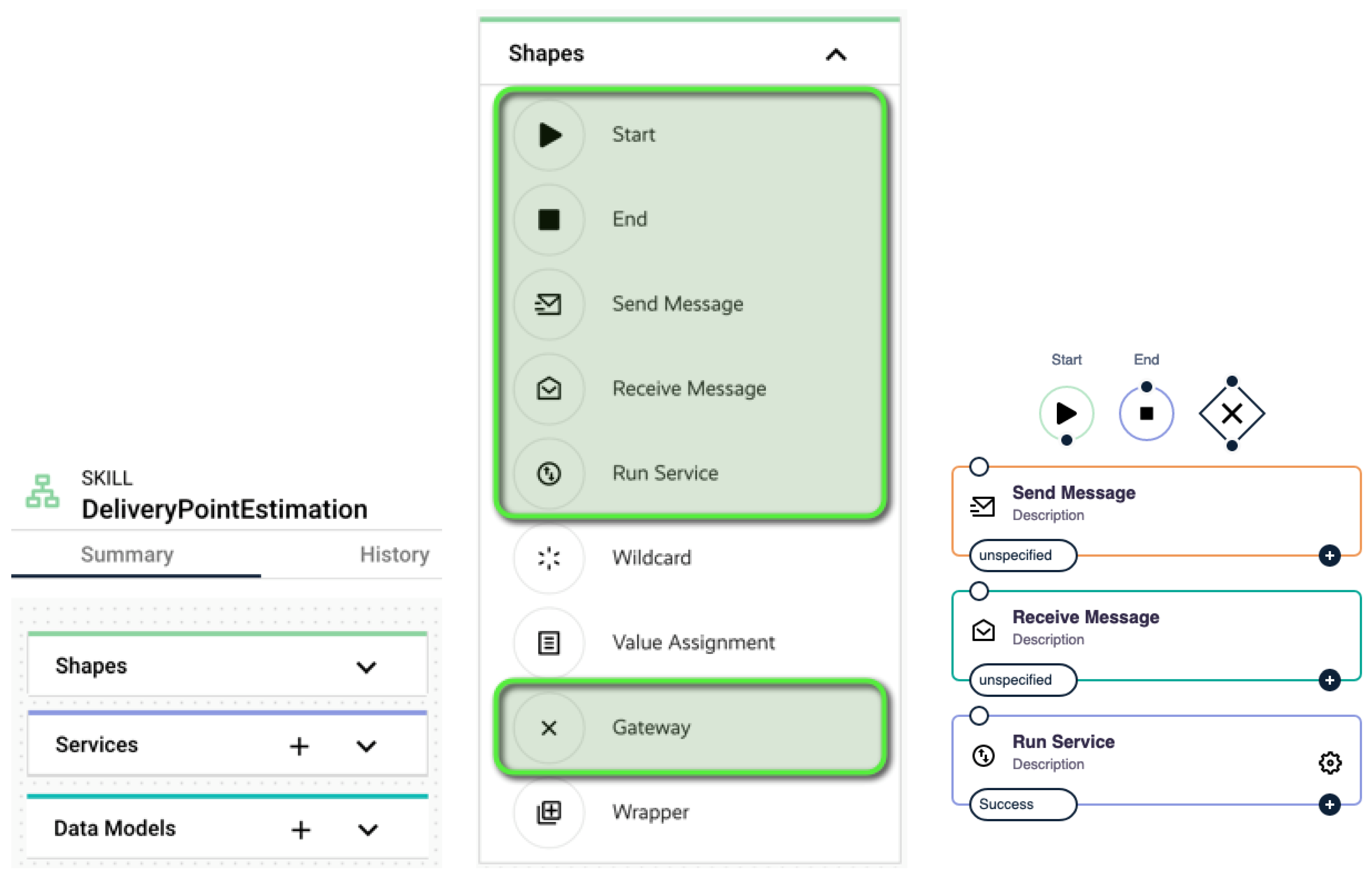
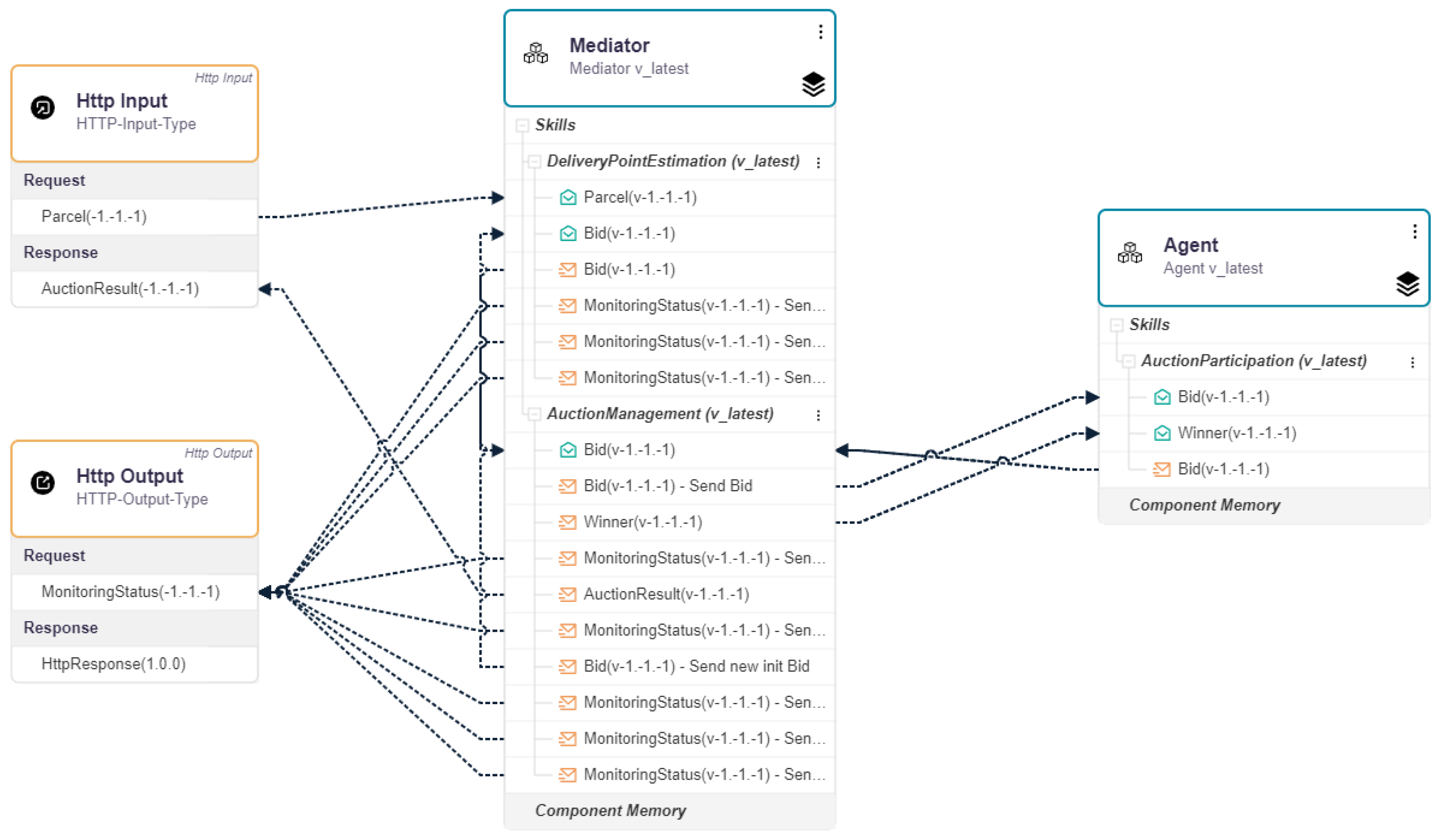
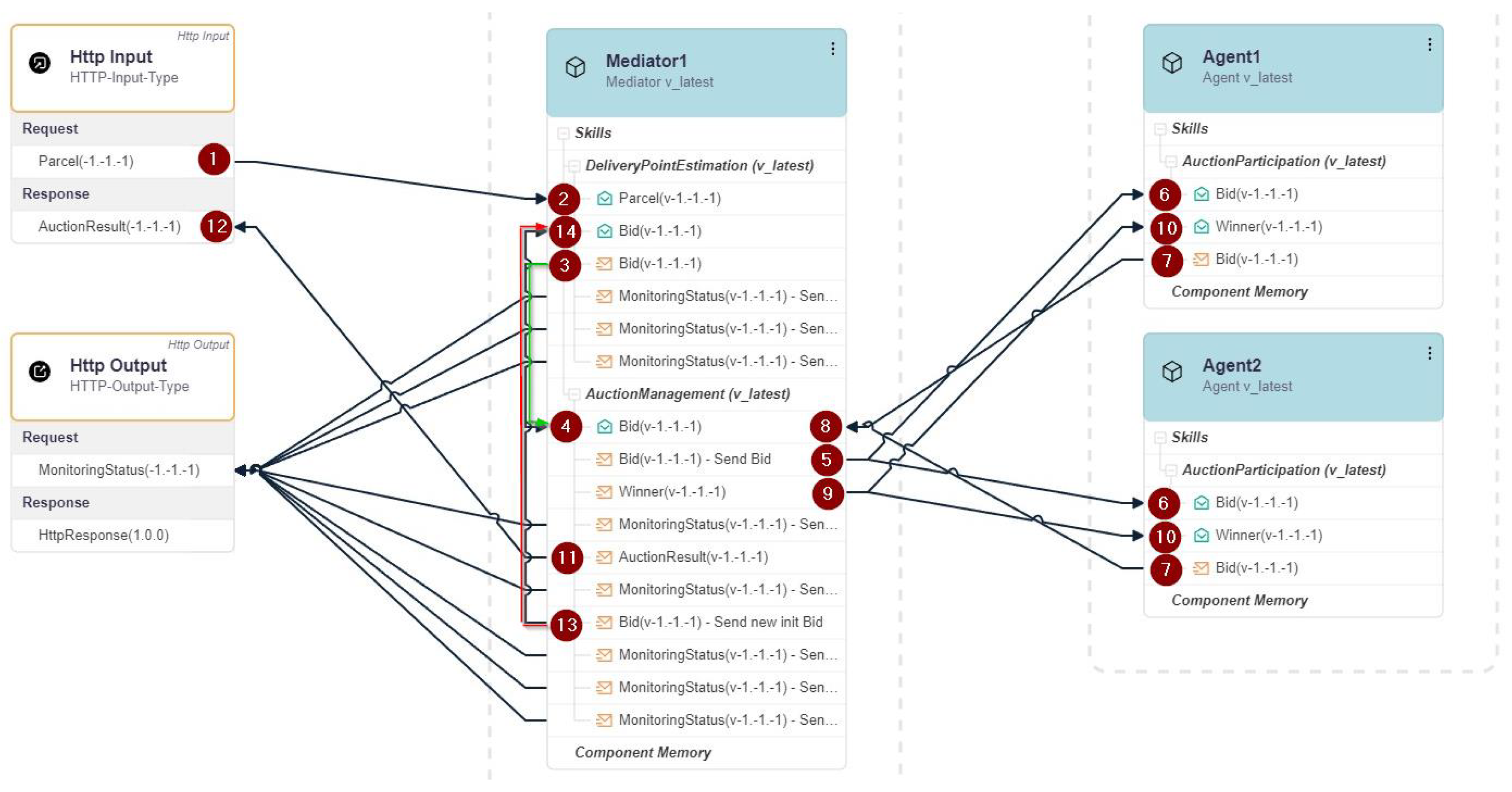
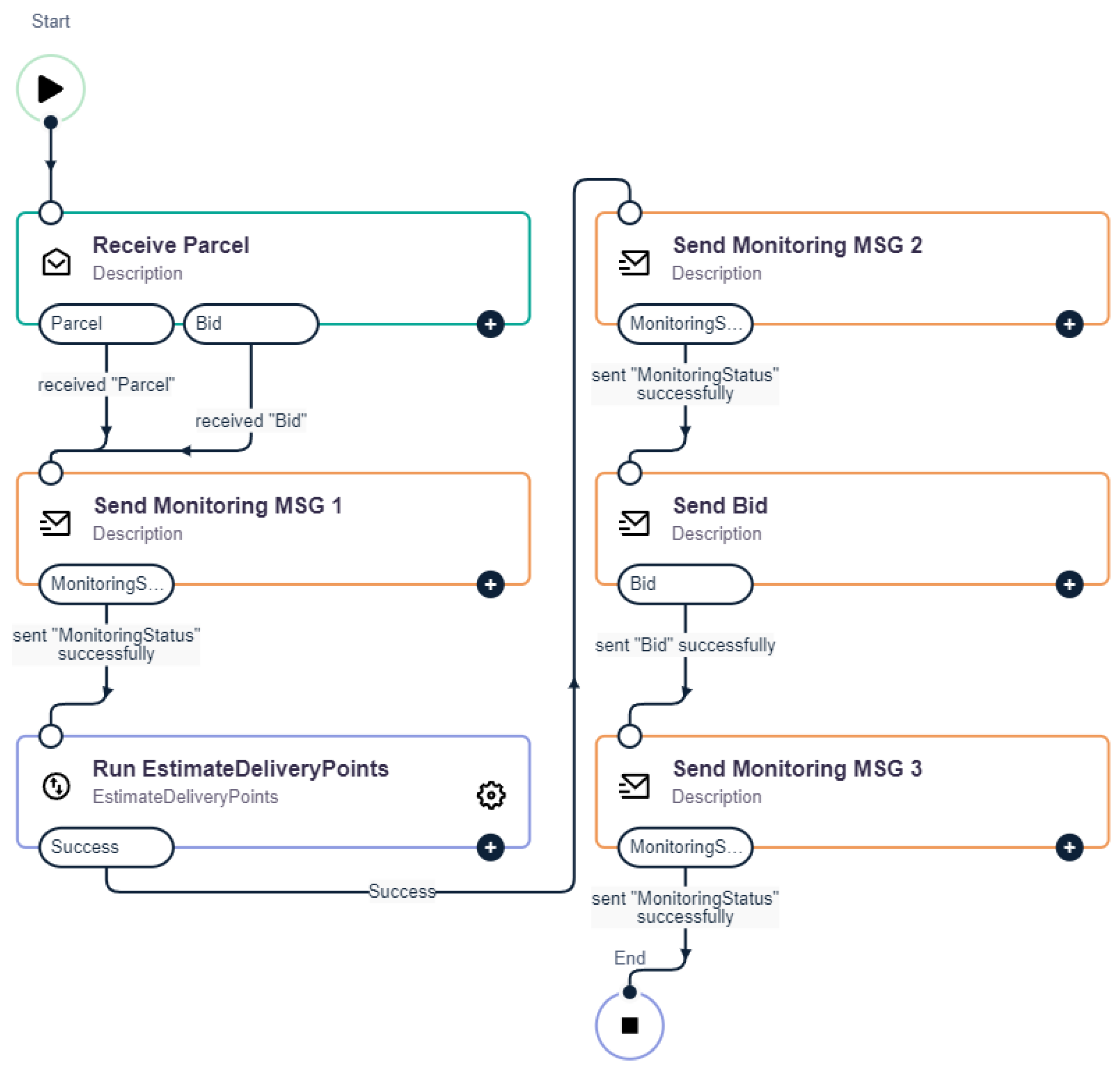
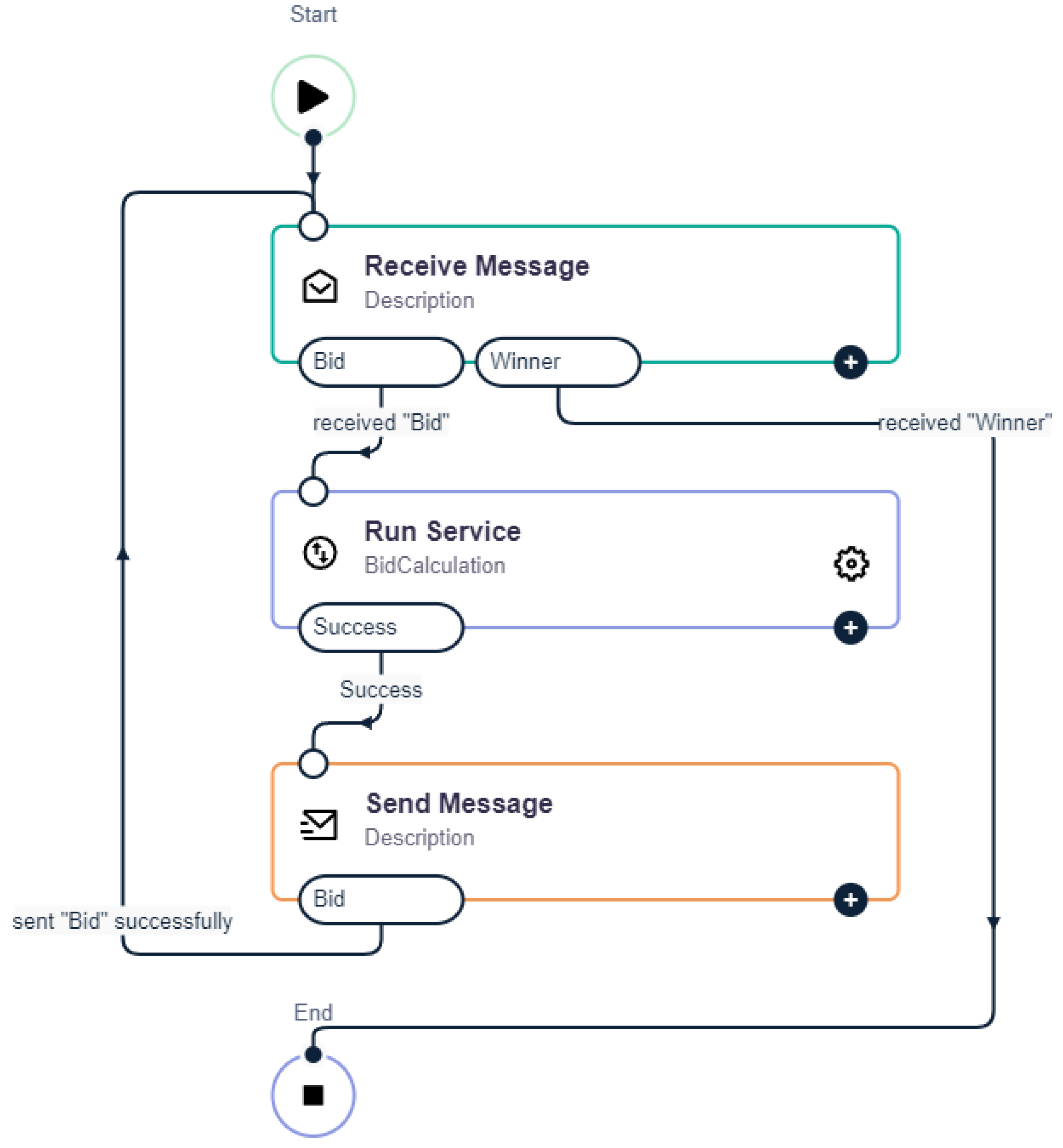
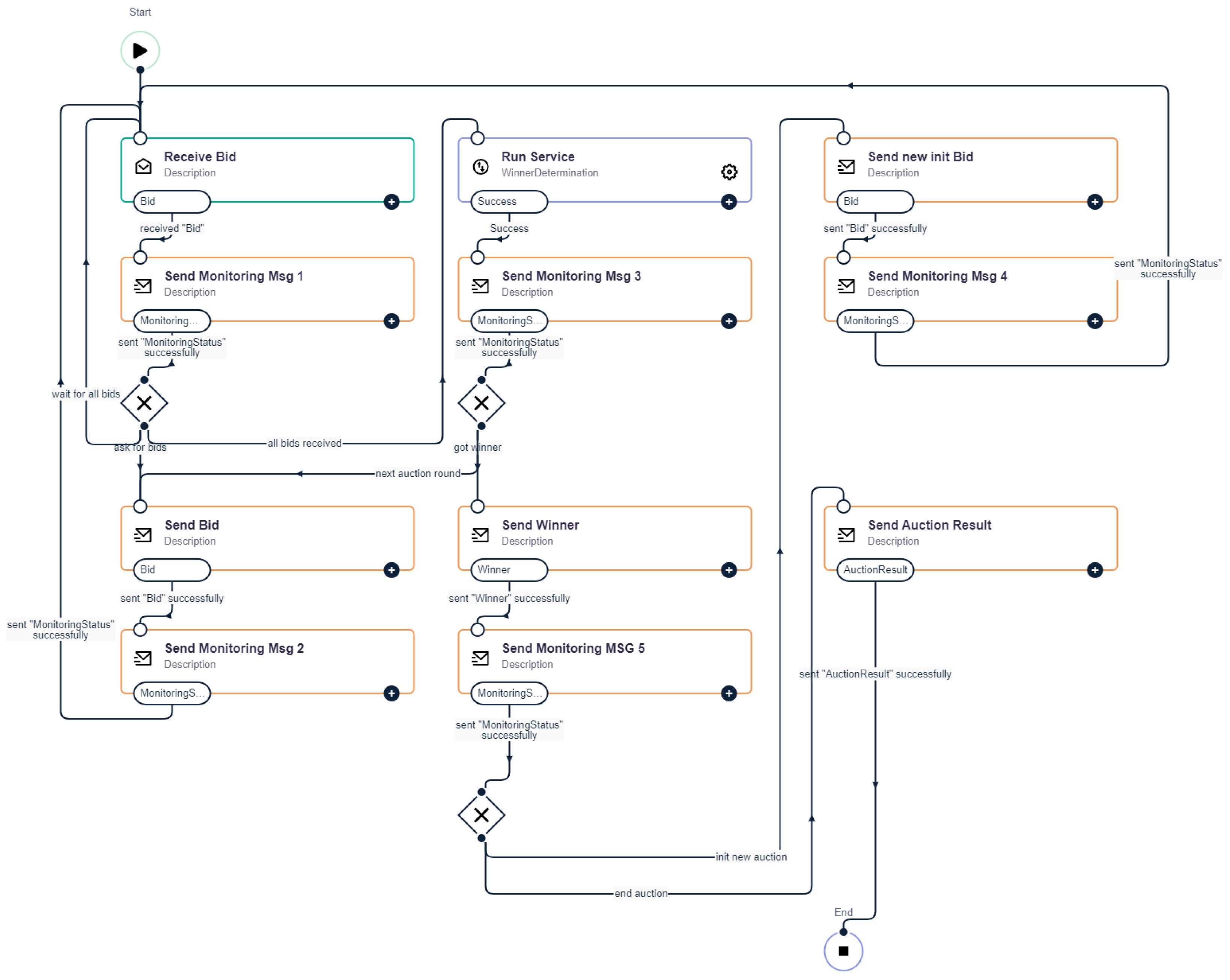
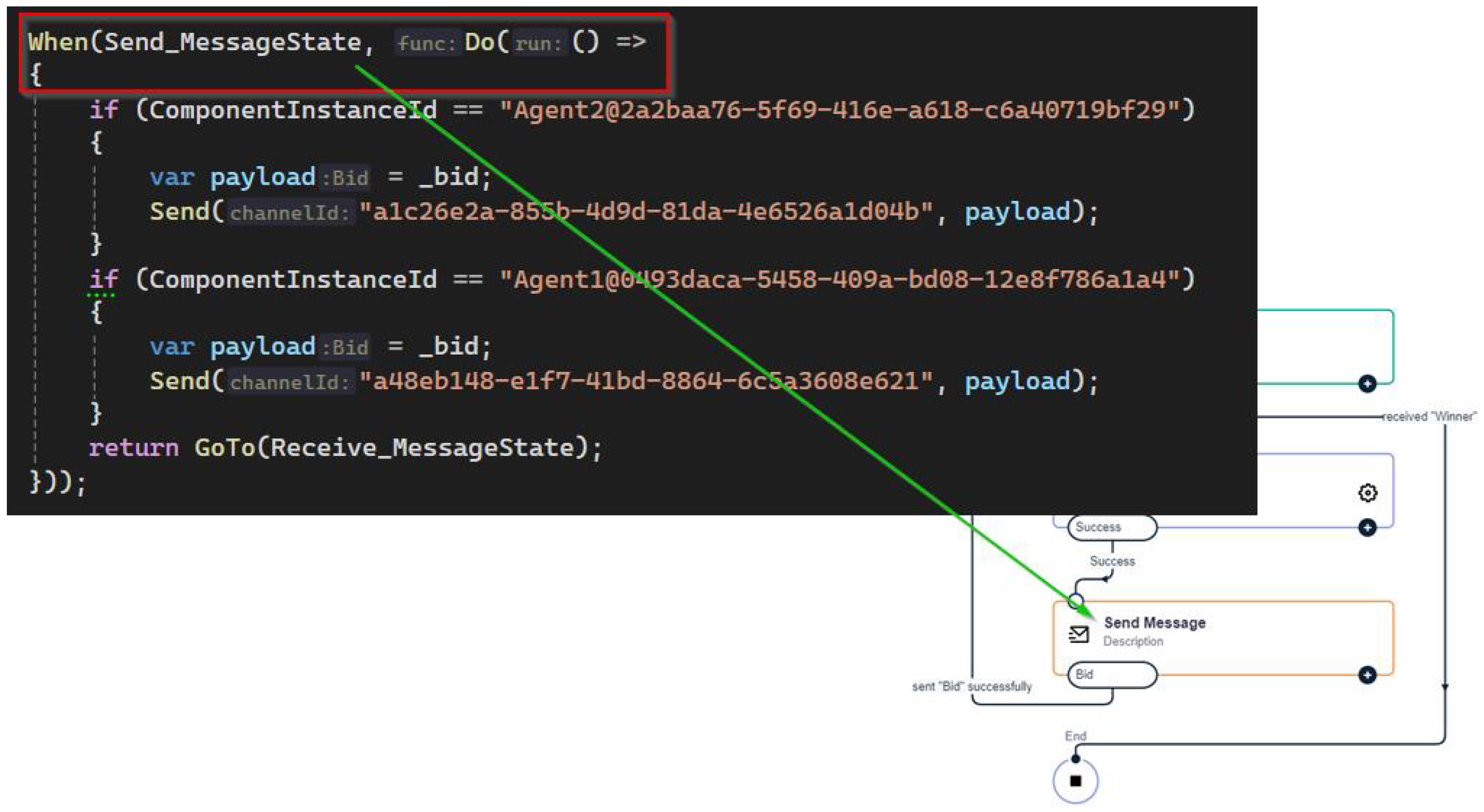
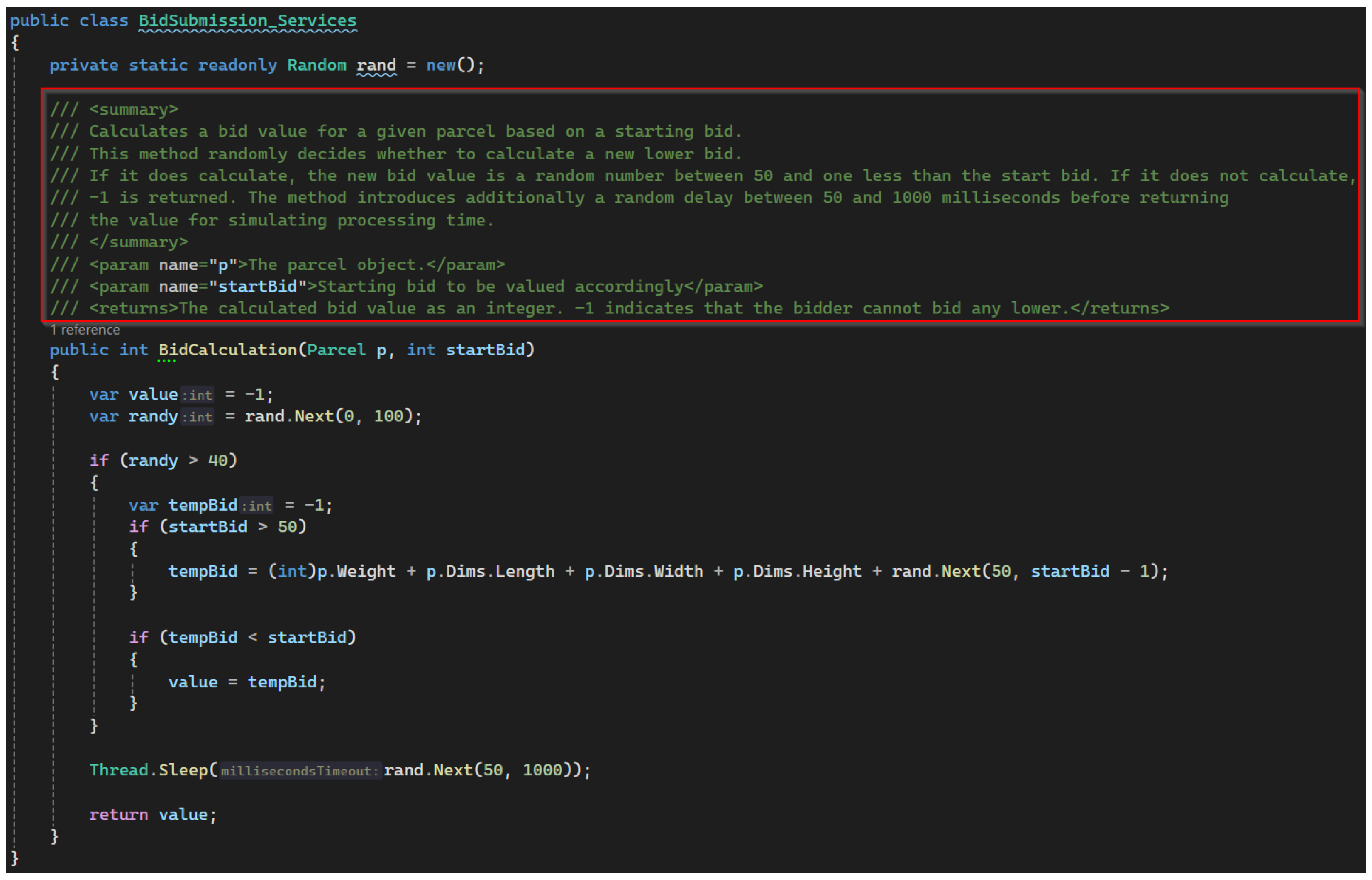




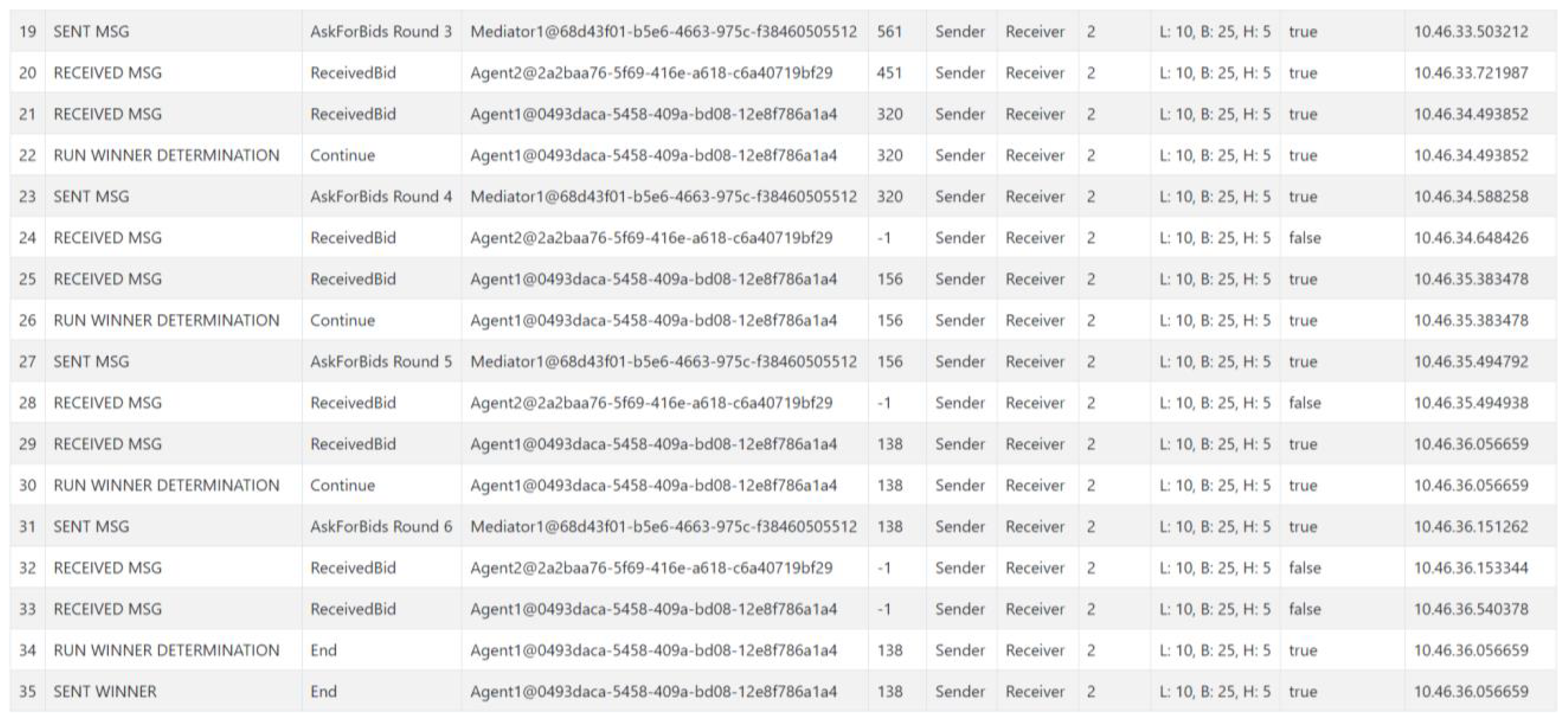
| TM | Value | TI | Value | V | Value | DP | Value |
|---|---|---|---|---|---|---|---|
| TM1 | 1 | TI1 | 1 | V1 | 1 | DP1 | 1 |
| TM2 | 1 | TI2 | 1 | V2 | 0 | DP2 | 1 |
| TM3 | 0 | TI3 | 0 | V3 | 0 | DP3 | 0 |
| Total | 2 | 2 | 1 | 2 | |||
| Weighting | 35% | 20% | 20% | 25% | |||
| Result | 0.7 | 0.4 | 0.2 | 0.5 |
| TM | Value | TI | Value | V | Value | DP | Value |
|---|---|---|---|---|---|---|---|
| TM1 | 1 | TI1 | 1 | V1 | 1 | DP1 | 1 |
| TM2 | 1 | TI2 | 1 | V2 | 1 | DP2 | 1 |
| TM3 | 0 | TI3 | 0 | V3 | 1 | DP3 | 1 |
| Total | 2 | 2 | 3 | 3 | |||
| Weighting | 35% | 20% | 20% | 25% | |||
| Result | 0.7 | 0.4 | 0.6 | 0.75 |
| TM | Value | TI | Value | V | Value | DP | Value |
|---|---|---|---|---|---|---|---|
| TM1 | 0 | TI1 | 1 | V1 | 0 | DP1 | 1 |
| TM2 | 1 | TI2 | 1 | V2 | 0 | DP2 | 1 |
| TM3 | 0 | TI3 | 0 | V3 | 0 | DP3 | 0 |
| Total | 1 | 2 | 0 | 2 | |||
| Weighting | 35% | 20% | 20% | 25% | |||
| Result | 0.35 | 0.4 | 0 | 0.5 |
Disclaimer/Publisher’s Note: The statements, opinions and data contained in all publications are solely those of the individual author(s) and contributor(s) and not of MDPI and/or the editor(s). MDPI and/or the editor(s) disclaim responsibility for any injury to people or property resulting from any ideas, methods, instructions or products referred to in the content. |
© 2025 by the authors. Licensee MDPI, Basel, Switzerland. This article is an open access article distributed under the terms and conditions of the Creative Commons Attribution (CC BY) license (https://creativecommons.org/licenses/by/4.0/).
Share and Cite
Wallner, S.; Heininger, R.; Stary, C. Towards Human-Centric, Traceable Negotiation Mechanisms for Sharing Autonomy in Multi-Agent Systems. Processes 2025, 13, 3329. https://doi.org/10.3390/pr13103329
Wallner S, Heininger R, Stary C. Towards Human-Centric, Traceable Negotiation Mechanisms for Sharing Autonomy in Multi-Agent Systems. Processes. 2025; 13(10):3329. https://doi.org/10.3390/pr13103329
Chicago/Turabian StyleWallner, Sebastian, Richard Heininger, and Christian Stary. 2025. "Towards Human-Centric, Traceable Negotiation Mechanisms for Sharing Autonomy in Multi-Agent Systems" Processes 13, no. 10: 3329. https://doi.org/10.3390/pr13103329
APA StyleWallner, S., Heininger, R., & Stary, C. (2025). Towards Human-Centric, Traceable Negotiation Mechanisms for Sharing Autonomy in Multi-Agent Systems. Processes, 13(10), 3329. https://doi.org/10.3390/pr13103329








